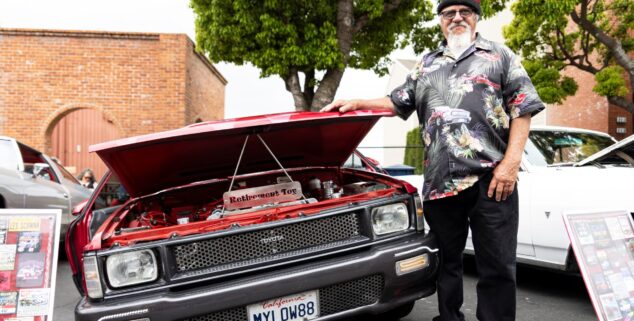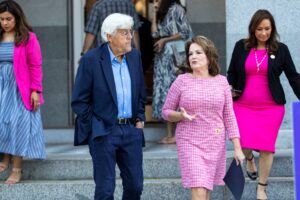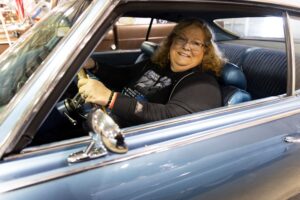News
Classic car community rallies support behind ‘Leno’s Law’
 Car enthusiast Gary Ellison. Image by Ellie Appleby
Car enthusiast Gary Ellison. Image by Ellie ApplebyIs the latest legislative effort to exempt classic cars from California’s emissions laws about to run out of gas?
The answer to that question could come as early as Friday when the Senate Committee on Appropriations weighs in on SB 712, also known as “Leno’s Law” for its support from former Tonight Show host and noted car enthusiast Jay Leno.
Current California law requires all vehicles built from 1975 on to pass a smog check every two years, with some collector’s cars partially exempted. The measure authored by Sen. Shannon Grove (R-Bakersfield) would exempt smog check requirements for cars 35 years or older.
The bill, she says, is about preserving both a piece of American history in car collecting and California’s long history associated with trading and selling of classic car and automotive parts.
“These classic cars aren’t just hobby vehicles—they represent generations of craftsmanship, culture, and community pride. With this bill, we’re protecting small businesses, empowering car enthusiasts, and preserving a vital piece of California’s heritage,” Grove said in a statement when the measure passed through the Senate Transportation Committee in April.
The measure is currently on the suspense file and will be voted on by the Senate Appropriations Committee on Friday.

Jay Leno with Sen. Shannon Grove. CA State Capitol April 8th. Image by Ellie Appleby
It is not the first time an effort has been made to exempt older cars from smog check requirements, none of which have been successful. But Grove says Leno’s involvement this time could be very helpful, saying “classic car enthusiasts are great people that have a desire and a passion to just restore old vehicles and create wonderful pieces of rolling history. They’re just amazing individuals, and Jay Leno putting his name on this to try and help those people is just really incredible.”
According to Credence Research, the global classic cars market had a valuation of $39.7 billion in 2024 and is projected to grow to $77.8 billion by 2032 as collectors seek to increase and diversify their collection and look towards them as future investments.
“Californians are fortunate to have weather that will preserve a thirty plus year car from rust that isn’t possible for car enthusiasts from other states,” says Association of California Car Clubs Board of Directors Rick Alvord. “This is a draw to buyers from out-of-state and globally.”
Without California exempting smog checks for cars between 1976 to 1993, the bill’s supporters say, it will be almost impossible for them to meet the current law’s demands, even though their vehicles are meticulously well maintained and seldom driven collectibles.
Car enthusiast Steven Benge says, “a classic car has already paid its dues [registration] for 50 years to be on the road, and now it’s only on the road on a weekend. Let it be. It’s not about driving these every day. It’s about show, it’s about restoration, it’s about community.”
Pollution vs. Culture
As the state implements tougher environmental policies to reduce pollution and fight climate change, its aim is to by 2035 have all new cars and trucks sold in California be zero emissions. But according to the California DMV, classic cars make up only 1% of all vehicles on the road since they are not widely used for everyday use.
Fritz Hamilton, who is part of several car clubs, including the Pacific Mountain Cruisers, a local chapter of the Toyota Land Cruiser association, believes the pollution from a seldom-driven classic car is insignificant when compared to that produced by the larger vehicle industry as a whole.
“It is such a low level that you drive once a week, once a month. Most collectors drive their car no more than an hour, because at the end of the day it is an old car. A modern car’s drive is more comfortable, it speeds up faster, it slows down faster, so you ride in a classic car to go on a fun trip or take your son or daughter to get ice cream, you’re not taking it out every day,” he says.
“Most collectors drive their car no more than an hour, because at the end of the day it is an old car.”
Car enthusiast Matt Hodgins believes lawmakers are not looking at the bigger picture.
“My opinion is that if they’re trying to stop the carbon footprint, then revive an old car. Then you will save a factory from producing a new car which has a bigger carbon output during the manufacturing process,” he says.
For classic car communities in California, their automobiles are also more than just a means of transportation. To them the hobby is a lifestyle fostering family camaraderie and preserving a piece of automotive history, as today’s automotive industry drastically evolves to more modern low-emissions vehicles.
Johna Pierce, the proud owner of a 1969 Oldsmobile 442 and the 2015 National Street Rod Association Street Rodder Lady of the year, views classic cars as a wonderful part of Americana history tied to iconic movies like American Graffiti and Van Nuys Blvd.

Car enthusiast Johna Pierce. Image by Ellie Appleby
“I’ve met people that I would have met no other way, except with classic cars. I met my husband because I have a classic car,” she says.
Alvord says smog checks are becoming more challenging for classic cars because manufacturers no longer support the equipment for older vehicles, making it increasingly more difficult to find a place that will repair whatever component required to pass smog.
“Everybody loves to put their own spin on their car, just a simple thing as a dual exhaust, or you know, maybe souping up the motor a little bit, trying to make it run better. There is a whole market aftermarket that’s involved in this as well. Because, as more cars become available to modify, then manufacturers can make more equipment for those vehicles as well,” he says.
But not everyone believes the emissions from classic cars is a minor pollutant.
The California Air Resources Board (CARB), the agency most noted with the state’s efforts to reduce vehicle emissions, declined to comment, saying it does not discuss pending legislation. The American Lung Association, however, had no such qualms.
Will Barrett, national senior director for clean air advocacy at the American Lung Association, called SB 712 “one of the most problematic air quality bills of the year.”
“Older vehicles pollute a lot more than modern vehicles,” he told the Bay Area News Group earlier this month. “It’s that much more important to have them in the program to protect against millions of extra miles of smog emissions that would come as a result.”
Brendan Twohig, who spoke at the April 8 hearing on behalf of the California Air Pollution Control Officers Association [comprised of executive officers from all 35 local air districts] said California Air Resources data that shows that a 1982 passenger car that passes smog check emits approximately 123 times the Nox emissions of a 2025 car.
“So assuming a 1982 car has driven just 3,000 miles in a year, it’s Nox [nitric oxide and nitrogen dioxide] emissions are equivalent of a 2025 car being driven 369,000 miles per year. And then for daily drivers, which would be allowed under this bill, at 11,000 miles a year, that’s the equivalent of 1,353,000 miles,” he said.
Twohig believes that without smog checks, emissions equipment can be tampered with or fail altogether, resulting in air pollution impacts that can be substantially high.
“So assuming a 1982 car has driven just 3,000 miles in a year, it’s Nox [nitric oxide and nitrogen dioxide] emissions are equivalent of a 2025 car being driven 369,000 miles per year.”
Bill Magavern, policy director for the Coalition for Clean Air, argued at the hearing that the bill should be called the Smog and Soot Bill, because that’s what you get if you loosen smog checks. “My wife recently was caught behind a parade of classic cars, came home with a headache because, you know, you can really smell the fumes in the air,” he said.
He also points to the health concerns that are overlooked, including those for older adults and children with weakened respiratory systems.
“Ozone or smog damages the respiratory tract, causing inflammation and irritation, resulting in coughing, chest tightness, and worsening of asthma symptoms,” he said.
Benge feels that the threshold should keep changing because classic car lovers are a family-friendly community that just wants to pass down their love and knowledge for classic cars to the next generation.
That is what Pierce has done with preserving her classic car that she plans on passing down to her daughter and then her granddaughter.
“I posted that I was going to the Autorama and I had a reply back from a guy that loved my car and asked me if I would sell it. I said, no. He said what about $30,000? I said no. He said what about $50,000? I said no. $100,000? I said no. He said what is your price? I said my car is not for sale for any amount of money. It’s going to my daughter. That’s how much it means to me.”
Alvord believes that California is the place where it all started.
“So to think that it’s slowly dwindling down because the cars that you can modify are getting fewer, I fear manufacturers will leave the state,” he says.
And that, he says, will mean revenue generated by the industry will also exit the state.
“Where are we going to go if they cannot manufacture for this state? We’re going to go more out of state, since that is where more of the market is heading thanks to stricter regulations,” Alvord said.
If endorsed by the Senate Committee on Appropriations, the bill will move to the Senate floor.
Ellie Appleby is an intern with Capitol Weekly.
Editor’s note: an earlier version of this story mistakenly said California was looking to phase out gas vehicles by 2035. That is incorrect – the state is aiming by 2035 to have all new cars and trucks sold here to be zero emissions. We regret the error.
Want to see more stories like this? Sign up for The Roundup, the free daily newsletter about California politics from the editors of Capitol Weekly. Stay up to date on the news you need to know.
Sign up below, then look for a confirmation email in your inbox.

[…] output and its deleterious effect on the climate and on human health. I recently read a story on Capitol Weekly, a news site about California politics, and in that article were a number of scary quotes about […]
I cant find someone to do a smog check on my 1989 Mustang, businesses don’t want to maintain the equipment for the older cars they say its to expensive!
It’s absurd and expensive for smog test businesses to invest in equipment that only tests a handful of cars every year. Also, the car collector hobby will become prohibitively expensive if enthusiasts have to continually upgrade their engines to meet smog passing requirements. It will kill the hobby in CA, and force hobbyists to register their cars out of state, like Montana, to avoid the excessive scrutiny on their vehicles. As a result, that would actually reduce CA revenue collection.
My 84 Chevrolet C10 just sits in my garage anyway. I’ve restored it about 85%, but can’t do anything to the engine because of all that smog b.s. Finding a smog shop to do it is another P.I.T.A. These older ones are rarely daily drivers…mine is for weekend fun..if that.